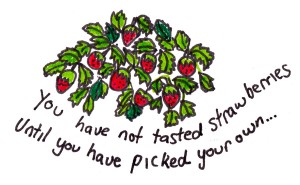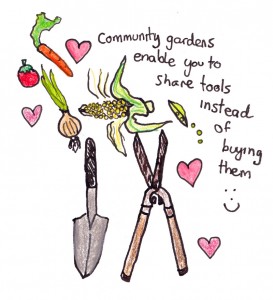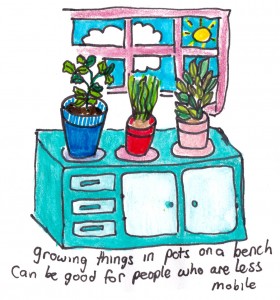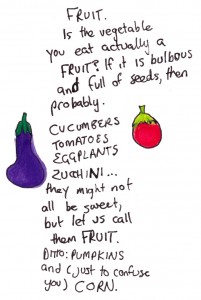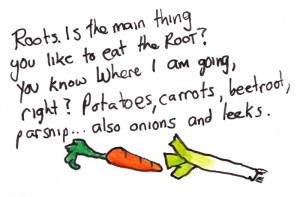Planning your garden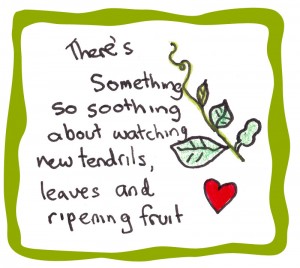
This is one of the most important parts of gardening, and yet so many people don’t bother with it. Proper planning enables you to build a garden you are not going to lose interest in after a few weeks. Please do not skip the planning phase and just throw things in the ground. Please don’t do that. It’s not worth it!
Proper planning will ensure long term success. It enables you to tailor your garden to your needs and abilities. Most important of all, it inoculates you against failure and disappointment. I’d say the number one mistake beginner gardeners do is that they don’t spend enough time planning.
They figure they’ll just bumble along and then they become discouraged when the inevitable ‘unforeseen circumstances’ come along.
Rosy-cheeked with dreams, they race out and whack everything in, willy-nilly, only to find in a few months that their garden is failing to thrive; it’s spindly and unable to resist attacks by pests.
Disheartening, much? The sad thing for me is that these people could have had something much closer to the garden of their dreams if they’d just took the time to plan a little. Truly, the only thing separating good gardens from bad is planning.
This week, I will focus on picking a style of gardening that suits you and getting everything you need together for your garden.
I will also explain the best way to draw up a little map. It’s not a complex process, but mapping the garden can make a big difference.
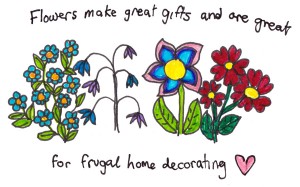 Picking a set-up that’s right for you
Picking a set-up that’s right for you
There are different gardening set-ups that you can use and choosing correctly can transform your whole experience of gardening.
It’s worth putting a bit of thought into this because if you don’t, you might end up choosing a form of gardening that isn’t right for you and you are more likely to give up.
Back yard veggie patch
Pros:
- It’s right there, in your back yard.
- You can have your compost, worm farm and supplies nearby, saving some lugging around. It’s a great thing to have around the place.
- Establishing a bed is cheaper than buying potting mix for pots.
- You can show it off and share your produce with visitors.
- It’s a nice homey thing to have nearby. It’s mighty handy to be able to pop out the back (or front!) for your herbs or salad ingredients.
- You get total control over your garden and don’t have to abide by policies and principles that might be imposed at a community garden. We grow our tomatoes and capsicums at home because we can use a pest control technique for fruit fly that is not allowed in our community garden.
- Obviously, this is not suitable if you don’t have a back yard.
- It may also be unsuitable if you are renting or unsure how long you will be settled in your home.
- You will need to buy tools.
- Can be very labour-intensive if you have not got beds dug already.
- The soil in your back yard may be poor. This needn’t be the end of the world, but it can take quite a long time to correct the problems and it’s not always a straightforward process. In fact, it might be several months before your soil is ready, and years before it is optimised for growing veggies. It’s possible, but it takes work. For more information, see my section on soils.
- You will need to buy expensive tools, like gardening forks and spades.
- Veggie patches can be tricky if you have pets that destroy the garden, or if wild animals like possums are a problem in your area.
- It’s also not a great form of gardening for anyone with chronic health conditions and certain disabilities.
Community garden
- The mentorship: endless lessons on growing great vegetables without paying a dime. Gardening is a bit like fishing: people LOVE to share their expertise. This is a good thing! I have learned so much from experienced elders at the garden, about everything from fertiliser to pest control.
- Chances are, the community garden is set on reasonably decent soil which has already enjoyed plenty of attention.
- Depending on the set-up, you will have an instant garden bed.
- You get organic produce that costs nothing but time.
- Community gardens are wonderful social scenes for your family that actually save you money.
- You save yourself a lot of planning, money and hard work. You have effortless access to pre-made beds, infrastructure and tools are already there for you to use. This way, if you find that gardening is not your cup of tea, you have not invested in a stack of tools that will do nothing but gather cobwebs in the back shed.
- Community gardens can be great places for people with disabilities. Another great thing about community gardens is that many of them are becoming quite proactive about improving accessibility to gardening for people with disabilities.
- Our garden has received funding to improve wheelchair access and we are now set up so that people who can’t bend or kneel can still garden in raised beds or help out and enjoy the communal process. This can be a big deal to people who would love to garden but who can’t due to mobility problems.
- Restored faith in humanity. The other really fantastic thing that community gardening has going for it is the community who garden. Members tend to be real ‘doers’. I like doers. They’re uplifting. They don’t sit about complaining. Instead, they are being the change they wish to see in the world. They are friendly, they are community-minded and they remind you what community is all about.
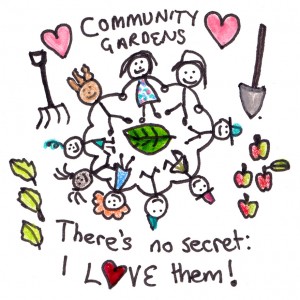 Access to other cool things, like sustainability and cooking courses. Some bigger community gardens have other affiliate groups you can join – they may run workshops, for example, or community groups may use the garden for varying reasons. We have a group of home schoolers who come and build scarecrows and learn to garden. The community garden is such a happy, welcoming, family-friendly scene.
Access to other cool things, like sustainability and cooking courses. Some bigger community gardens have other affiliate groups you can join – they may run workshops, for example, or community groups may use the garden for varying reasons. We have a group of home schoolers who come and build scarecrows and learn to garden. The community garden is such a happy, welcoming, family-friendly scene.- You might be required to invest a bit of time into the garden as part of your membership, but it is well worth it.
Cons:
- Travelling to and from the garden is a bit of a commitment, especially if it’s really hot and you need to water every day.
- You need to lug supplies, like mulch and fertiliser to the garden.
- You do need to attend a minimum number of working bees each year. At our garden it is a minimum of four per year.
- You might not have a local community garden.
Growing in pots
- Pots are portable. They can be a great option if you are living in a flat or a rental property where you might not stay longterm.
- Pots can be a fantastic option for people with mobility issues as you can set them up at waste height or in a way that works with your body.
- You minimise weeding and exposure to disease.
- Some indoor plants will do well with the added protection if there are frosts in your area.
- Pot growing can be excellent for people with limited strength or mobility. You can set things up to make life easy.
- You can move pots around to make best use of a plants sun or shade requirements or during extreme weather.
Cons:
- Pot growing can be very expensive.
- To a point you can get around this by using salvaged containers and by recycling your own potting mix. The micro-gardener offers up some great tips on how to reuse your potting mix, over and over again. More about this in my section on creating a windowbox, below.
- Some plants don’t grow well in pots so your range is limited.
- Potted plants need watering more often.
So, you have picked the patch (or pot) of dirt you will use. Now for some fun: what are you going to plant?
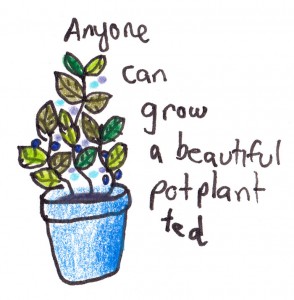 The next thing you want to do is plan the things you intend to plant in the garden. A word of advice here – proper preparation of soil does not necessarily happen overnight, and it might be weeks before your soil is ready to plant in. I recommend planning ahead by about a month to allow for preparation time.
The next thing you want to do is plan the things you intend to plant in the garden. A word of advice here – proper preparation of soil does not necessarily happen overnight, and it might be weeks before your soil is ready to plant in. I recommend planning ahead by about a month to allow for preparation time.
You don’t want to dig the soil over and throw everything straight in. Well, you can, but your yields will not be as good.
Considerations for these are
- Your climate;
- The amount of light your chosen patch receives; and
- The time of year you are planting.
This is when you need to jump online. There are plenty of resources to help you pick plants that will grow when and where you want to plant them.
I use a marvellous little app called Gardenate, which I’ve downloaded on my phone. I enter in where I am living and this groovy little app offers a comprehensive list of everything that will grow at various times of the year.
I’m forever whipping out my phone to check if it’s a good time of year to purchase a tempting punnet of seedlings. Apps like Gardenate will not only tell you the climate a plant grows in, but should also offer advice about the light, shade and space requirements the plant needs.
This is important.
If you plan a tiny little space for your pumpkins, for example, they will not thrive as pumpkins need plenty of room. The same applies for plants requiring sunlight or partial shade.
Once you have found a list of plants for your climate and season, plot away!
Draw a little map as a rough guide, pencilling in things that you would like to grow. As you do so, consider light requirements.
A plant that doesn’t mind a bit of shade will not be bothered if a bigger plant blocks the sun for part of the day, for example.
Another thing to consider is how long it will be before your soil is ready for planting.
Providing your soil is not clay or sandy, you should definitely be able to start planting a month from when you first start preparing the soil. Factor that in when you plan because it might be a different season by the time you get planting. Even if you don’t want to plan the specifics straight away, you can divide your plot into four general areas and decide the specifics later.
Legumes, leaves, fruits and roots
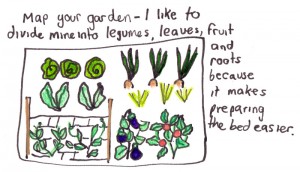 I picked up a great little system from my community garden that I like to use when I’m planning.
I picked up a great little system from my community garden that I like to use when I’m planning.
I split my plot into four groups – legumes, leaves, fruit and roots.
Each of these four categories have slightly different needs in terms of soil nutrition.
Different gardeners will categorise their plants slightly differently, but if you divide your plants into these four, it will make it much easier when you go into the nursery for advice.
I will go into this in greater detail next week. I recommend doing this. If you are in a cooler climate, you might not be growing fruit in the winter. Just plant more leaves. I’ll explain why in a later post on rotating the crops in your garden.
Don’t worry too much, though… Frugal Frank and I have also just bunged things in without any planning at all and it’s usually not a problem if we’ve made some effort to care for the bed.
As long as the soil is not terrible and has some good nutrients in it, it should support most plants reasonably well.
Once you’ve planned and dreamed, it’s time to take action. Now the fun really begins. Want to know more? Tune in next week, mamas.

